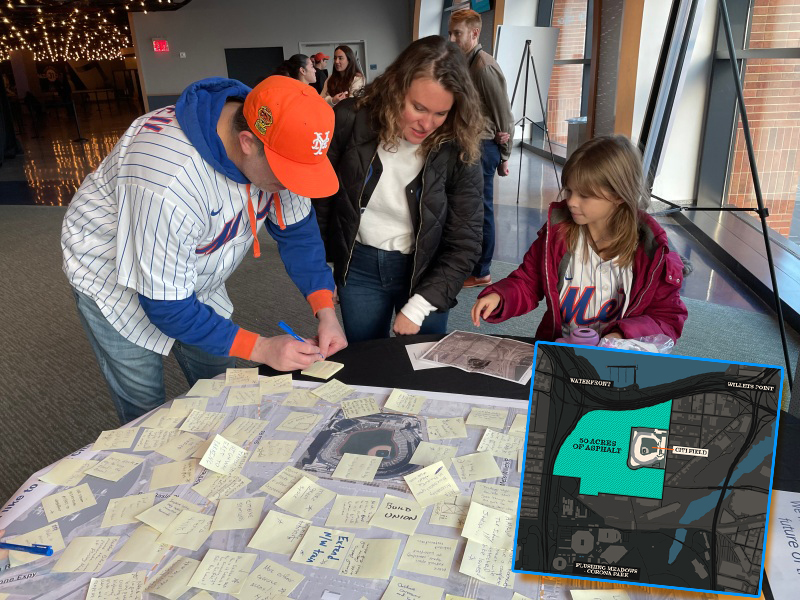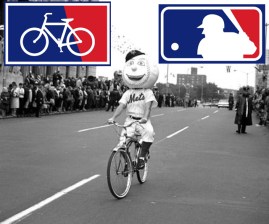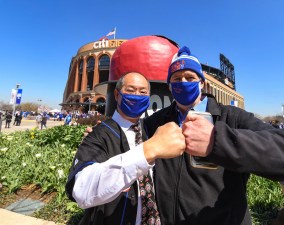Fans to Mets Owner: We Don’t Want to Drive to Citi Field

Bike to the Mets doesn’t just have to be a Twitter satire.
New Yorkers who showed up at a “visioning session” on Saturday to discuss the future of the parking lots surrounding Citi Field put cars low on their power rankings.
At the session, hosted by Mets moneybag/owner Steve Cohen, attendees were asked how they got to Citi Field that day and how they’d like to get there in the future. A sizable plurality of the meeting attendees got to the session by private car, but when asked how they wanted to get to the ballpark, that number collapsed like the Mets did at the end of 2022 (see chart below).

“There’s really no segregated [bike] lane, so that would be the main thing would be improving that to get here,” said Astoria resident Eric Kincaid as he gestured to terrifying Roosevelt Avenue underneath the 7 train tracks, where Citi Field-bound drivers speed after getting past the congestion of Corona to the west of the stadium. “It would be so much easier to bike here; right now I have to take the N to the to the 7, there’s a whole lot of waiting.”
During the 2022 season, the Mets added a short section to its media guide offering directions for biking to Citi Field, which the team previously did not promote. But the directions merely said that someone can bike to Citi Field if he or she wants, and doesn’t offer advice on safe routes to the field (perhaps because there are none and crashes are frequent).
Meeting attendees also left multiple sticker notes asking for bike and pedestrian improvements around the ballpark, and one ambitious attendee envisioned a protected bike lane map around the stadium.
“I usually drive, but my family members take public transportation, and some of them bike,” said Michelle Dunston, a resident of Lefrak City. “I don’t bike, but I think that it’d be a good idea, I think that’s a smooth way to travel. But you’ve got to be careful around the cars, because there’s too many cars now.”
The exact future of the parking lot will be caught up in a possible multi-year ordeal over Cohen’s interest in putting a casino in the area. The parking lot is still legally part of Flushing Meadows Corona Park, so any move to demap the parkland for the casino or any other non-park use would require state intervention. But with the city adding a soccer stadium and an entire new neighborhood’s worth of homes on the east side of Citi Field in the upcoming years, state legislators said there’s no need to tie safer street infrastructure to the fate of a casino or ballpark district or other redevelopment of the parking lot.

“I don’t think that we need a casino in order for that to be done,” said State Sen. Jessica Ramos, who attended the workshop. “We need bike lanes yesterday. For eons, so many of us have been talking about coming down 34th Avenue and crossing over the highway [exit and entrance ramps]. There’s all sorts of issues there, and cars don’t properly stop, it can be very dangerous. Ideally, I would love to bike to a Met game with my kids on a nice summer day, but right now, I don’t feel that that’s something I can consider.”
And of course, the future of mobility around the ballpark is a rare instance in American governing where the whims of a billionaire may not determine the outcome, since Cohen can’t add protected bike lanes by fiat. But a meeting attendee who spoke to Cohen at the gathering said he was willing to listen to advocates for safe streets and that she was encouraged by how receptive he was.
For the first time, Streetsblog has plotted the 97% more crashes and 77% more injuries near Citi Field during the baseball season vs. in the @mets off-season. @TransAlt @MrMetBikes https://t.co/XbNTkPNxsS
— Streetsblog New York (@StreetsblogNYC) October 19, 2022
Receptiveness was the goal of the event, said a representative for the project: “The first step in this is listening to the community to understand what their priorities are. From there, Steve Cohen has told his team that anything that we do needs to improve upon the current situation, and especially with transportation. We want to make sure that we’re improving the experience. We want to work with our partners and the city and the state to make that happen. But the first step in this process is listening to community understanding it and digesting some of that feedback and getting a better sense of what we can and should be doing for the space.”




